
De Roode Leeuw
|
It was a warm night, and Rex and Meryl had kept the front hatch open on the boat. A thousand squadrons of mosquitos had spotted this and took advantage. All night long the pesky little vampires had extracted their toll on our blood supplies. We were a complete and utter mess by morning.
The one thing I needed more than anything else in the morning was a shower; we needed a bucket full of 50 cent pieces. I walked across to a huddle of retail stores and persuaded a young lad on one of the tills to exchange a handful of shrapnel for ten 50 cent pieces. Now we can all have showers.
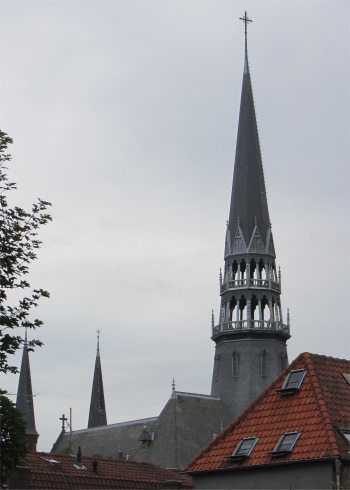
Gouwekerk
|
With the threat of rain rolling in over the North Sea, we headed into town and strolled down Vest which ran adjacent to the Turfsingel Waterway, passing the very tall "De Roode Leeuw" (red lion) mill. Its sail cloths were fully out and it was turning in the breeze. It appeared to be a residential property now, perhaps they use the wind power to produce their own electricity.
Just past the mill, laid up in the Turfsingel, were lots of old barges from various bygone eras. This stretch was the Museumhaven (harbour museum). Gouda played a major role in shipping as early as the 12th century. In the Middle Ages, with its central location, the town offered passage to ships en route to Amsterdam and Flanders. After the 15th century, Gouda's role in international shipping went into decline. Today, in stately poses along the Museum Harbour, you can still find historic clippers, barges, tjalken (Dutch sailing vessels with characteristic spritsails), tugboats and straight-stem barges.
While we were taking all this in, Rex and I studied a more modern, smart-looking vessel lower her mast electrically, obviously preparing to go through the Mallegatsluis into the Hollandsche Ijssel at the southern end of the Turfsingel. The lock slowly emptied of water, and a gate was raised ever so slowly, allowing the craft to enter the lock. No hurrying around here like headless chickens then.
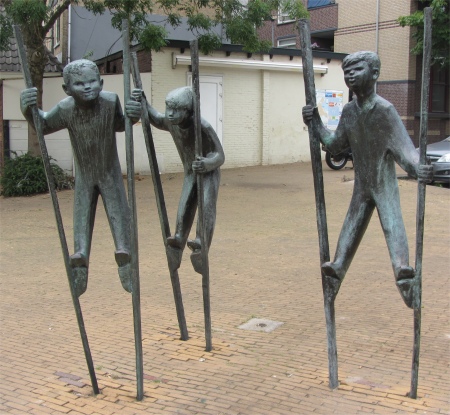
Me, Rex and Meryl on Tour
|
Sharing a narrow footpath with crazy cyclists and even crazier motor cyclists, we walked alongside the Hollandsche Ijssel, past the Tolhuis en Oosthaven, towards the "t Slot" mill, and headed up the Oosthaven by the canal.
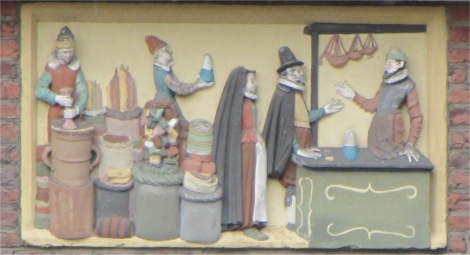
Charming Relief on a House in Oosthaven
|
Grand properties flanked the canal, and many small bridges criss-crossed it. At the top end, laying further back on the right hand side, towered Sint Janskerk, which we wanted to look around.
Walking alongside the church, its 123m length becomes very apparent, and it is classified as the longest church in the Netherlands. Many medieval towns did their best to build the highest church in the land, but in Gouda's soft soil length was the more appropriate choice. The church is dedicated to John the Baptist, the patron of Gouda. The symbolic colours of white (purity, love) and red (suffering), are frequently depicted in the stained-glass windows, and also in Gouda's coat of arms.
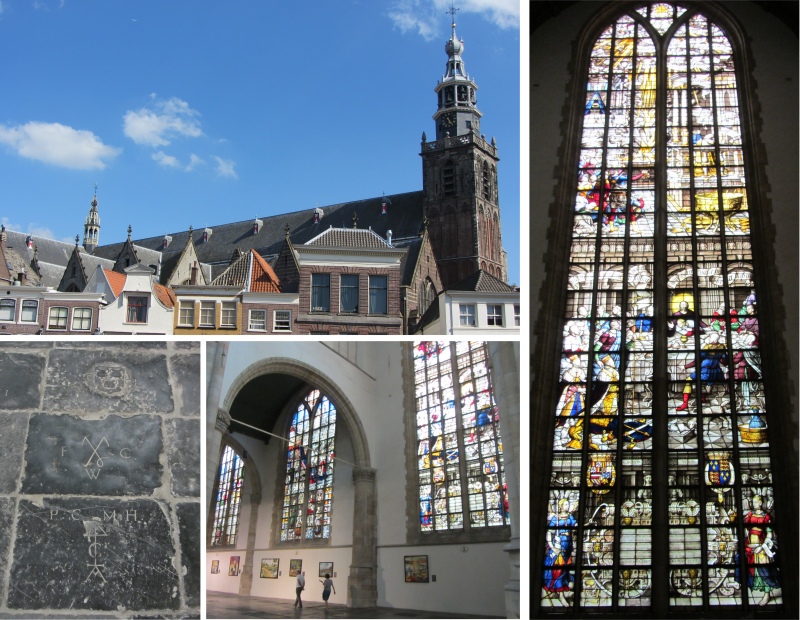
Sint Janskerk
|
Little is known about the oldest building, which was built around 1280. The church has a relatively small tower with a carillon whose bells stem from the famous 17th century Hemony brothers' bell foundry. The present church building, in the form of a cross basilica, dates mainly from before the fire of 1552. Until the Reformation of 1572 the church was used as a Roman Catholic church, which can still be observed in its lay-out. Spread across the nave and the aisle were at least 45 altars, belonging to Gouda guilds and were dedicated to saints. The choir section, separated by a monumental marble Choir Screen with copper bars from 1782, was only accessible to the clergy. Here, at the main altar, mass was said. In 1573 the church was assigned to the Protestants. The church building is still maintained by the municipality of Gouda Reformed Protestant Church in the Netherlands. Throughout the year there are concerts on one of the two organs or by national and international choirs and orchestras. Due to its great length, the acoustics of the church are particularly attractive. The organ was built between 1732-1736 by Jacob François Moreau. The small organ dates from 1975 and is a Leeflang / Keyzer organ. In the church floor many tombstones, often decorated with beautiful carvings, are reminiscent of a time in which people were buried in the church. Most people were middle class. Some very wealthy had even a tomb chapel built for the purpose. The last burial in the church took place in 1832.
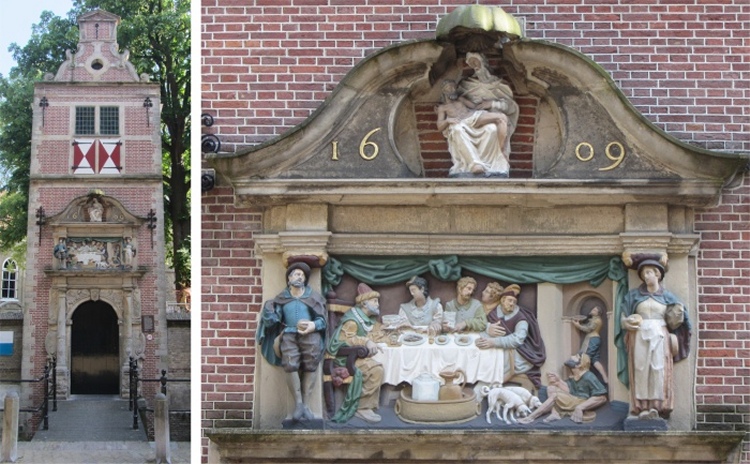
Gouda Museum Entrance
|
But what really struck me as we entered this enormous church was the collection of stunning 72 stained-glass windows, well known as the Gouda Glass. These were created mainly in the 16th century, and depicted Biblical and historical events in cartoon form. As it was quite expensive to make stained-glass windows, wealthy clergymen and nobles were invited to sponsor a window. In return, their images were prominently engrained in the window. Images of bishops, Golden Fleece Knights, and even kings such as Philip II of Spain and Mary Tudor of England were depicted. Because many people could not read at the time, a type of pictography was employed that everyone could understand. The dog, a symbol of faithfulness, reappears in some 20 windows. However, at the foot of the corrupt king Herodes lays a bear - symbol of iniquity and sin.
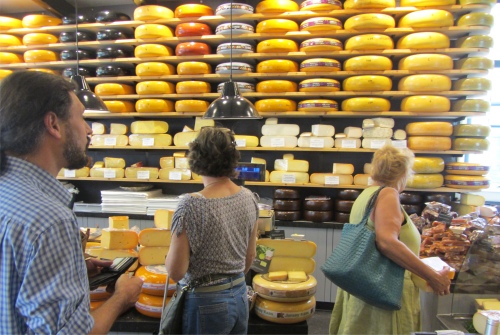
Delicious Kaaswinkeltje
|
We refreshed ourselves with coffee and appeltaart in the gardens of the Museum Gouda, before spending an age inside the museum. The building dates back to the 14th century, when it was a guest house for vagrants. Over time, the sick and elderly were also taken care of here. The building was dedicated to Saint Catherine, and in the 19th century, it became a real hospital. Since 1947 a museum has been housed in this historic place. A duplicate of the old town pharmacy is located in one of the rooms. Artworks in the museum were grouped into four areas: work-related (art) history of the city and region, from 15th century to the 21st century, religious art from 16th century, Hague School and Barbizon School in the 19th century and finally Gouda Pottery from the 20th century. In the past, psychiatric patients were imprisoned in the basement. Apart from artefacts dating back to this phase, a unique collection of instruments for punishment and torture were housed down there, and pretty gruesome they were too. On the upper floor of the museum a room associated with surgeons was located. Here we learnt about their 1700s profession and grisly instruments. In the hallway hung a painting by Jan Steen, who had a low opinion of doctors and quacks. An excellent video of how a stained glass window is made was also shown in one of the rooms. The museum really gave an excellent account of the growth of Gouda from the original stretch of land criss-crossed by drainage ditches, through various developmental stages including the filling in of some of the canals, to the present day. The museum is well worth a visit.

Waag Reliefs - Notice the Farmer Holding the Scales Down with His Foot
|
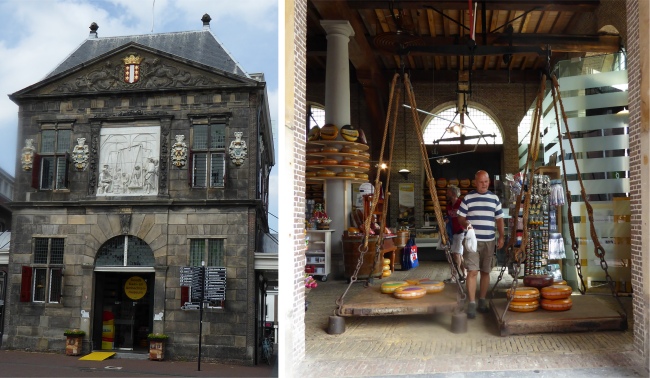
Waag
|
No visit to Gouda could be complete without a visit to a Gouda cheese shop, the most famous being 't Kaaswinkeltje on the corner of Lange Tiendeweg and Jeruzalemstraat. This was heaven. Large quantities of the cheese were laid out with bowls of small chunks of the various varieties of the cheese for tasting. Cheeses containing herbs, fruits, and spices were in abundance, as were older varieties and smoked variations. I could have spent all day sampling and re-sampling all the flavours on offer. For good measure, the shop also contained a large, diverse spread of French cheeses too. The proprietor was not short of custom, with many locals popping in for slices of this cheese or that, which she deftly guillotined off with her cheese cutter. We all bought some of the black rinded Oude Gouda cheese, which the shop kindly vacuum packed for us.
Poor Meryl was becoming parched by all this galloping about, so we retired up to the Markt to take in the Gouda Waag before having a cup of tea. The decision to build the Goudse Waag (Gouda Weigh House) was taken in 1667, and the famous architect Pieter Post was commissioned with the construction. The building was completed in 1669. The top floor was not important for weighing and was rented to the civic militia. Below, the commodities for sale were weighed and then taxed on the basis of their weight. From 1920 it was only cheese that continued to be weighed. In 1956 the building underwent extensive restoration and from 1995 the cheese museum was established at Waag.
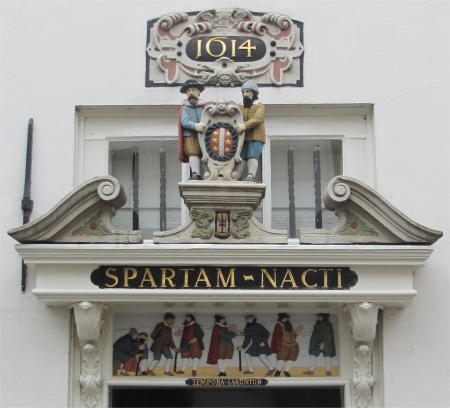
Above the Door of the Willem Vroesenhuis - Spartam Nacti, tempora labuntur (Sparta, time slips)
|
On the ground floor, six impressive large scales were set up, that originally would have worked flat out weighing cheese, rope, candles, bags of peat or whatever. A curator explained how weight was an important measure in those days, it enabled taxes to be handed out for virtually every item traded. Nowadays the building is the cheese and artisanal crafts museum, where you can find out about the history of the Goudse Waag and the products that used to be weighed and traded here. There are various regular demonstrations, including cheese making, Gouda candle dipping, pipe making and Gouda pottery (ceramics) manufacturing.
A kind volunteer upstairs took time to explain the story of cheese making in Gouda, including showing us a photo of the Markt in the 50s, when the square was full of hundreds of carts on which chesses were loaded. It must have been an impressive sight. A cheese market is still held in the Markt in front of the Stadhuis, though only on one day in the week, and sadly we would miss it. The chap also pointed out the original of the "weighing" relief attached over the front door of the building. It was made of marble, but the elements had badly eroded it.
A couple of ladies were selling cheeses in the building, and they let us try unpasteurised farmers' "raw" cheese. This had a much stronger flavour than their pasteurised cousins, and was softer too. Apparently the peaty ground gave Gouda its characteristic sweet flavour. Another aspect that we had not anticipated was the fact that the grass varied from season to season. Thus connoisseurs could detect the seasons by the flavour of these "raw" cheeses.
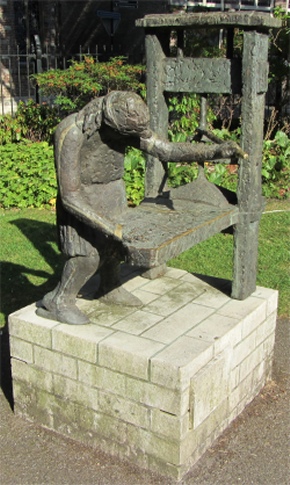
Printer Gerard Leeu in
Willem Vroesentuin
|
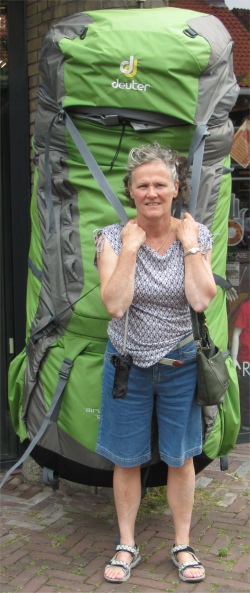
Meryl Enjoys a Big Shop
|
Above the front door the replacement copy of the large marble relief stood depicting a batch of cheese being weighed. The farmer sticking his cheeses on the scales is holding down his side of the scales with his foot, another touch of Dutch humour. Reliefs also stood on the sides of the building.
We took in a tea, and wandered back down to the Willem Vroesenhuis. Willem Vroesen (1478-1561) was a very religious Gouwenaar, who held several important positions in the city and dealt in real estate. He left in 1555 leaving his own house for old men. The white facade in Empire style was applied in the 19th century. On the side is a gate surmounted by a picture of old men and regents. The house has an attractive courtyard. Opposite the façade is the Willem Vroesentuin (Willem Vroesen garden). Until 1832 this was the cemetery of St. John. In 1850 the old men bought the land for a park to be constructed. In the garden were two sculptures, one of the printer Gerard Leeu, who was born in Gouda and operated two small printing presses there until 1484, when he relocated his practice to Antwerp. The other was of Desiderius Erasmus (ca. 1467-1536), the great 16th century thinker and writer, who spent a large part of this youth in Gouda. Nearby were the Huize Groeneweg (former monastery) and the Swanenburgshofje (courtyard)
Bodies were now flagging, so we meandered down back lanes past the Agnietenkapel (chapel) to the Vrouwetoren (clock tower), which was partially on the tilt, and of course closed.
A brisk walk returned us to
Duonita. The wind was really getting its dander up now, scudding dark clouds whipping past threatening to douse us in rain.
After a spat of rain, we returned to the town centre in the early evening, found a restaurant hidden up an alley, the Bij Ons, and enjoyed an excellent meal. Rex supped a beer brewed in Texel, the island we had cycled around a couple of years ago. Indeed, he had quite a few beers and really enjoyed them. I enquired of the head waiter the alcohol content of the beer, "7%", was the reply. No wonder Rex was merry.
We settled down for the night, smothered with Deet, ready to do battle with the mosquito squadrons.












